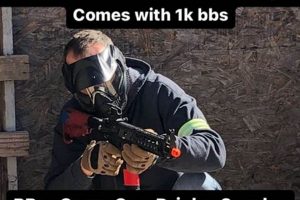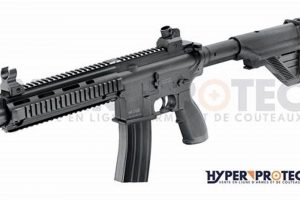This mechanism in airsoft replicas simulates the action of a real firearm. Following the discharge of a BB, the slide or bolt cycles rearward, mimicking recoil and ejecting a spent casing (in some models). This feature primarily enhances the realism and immersive experience for the user.
The incorporation of this functionality offers several advantages, including improved training capabilities for simulated firearms handling and a more engaging recreational activity. Historically, this technology represented a significant advancement in airsoft design, moving beyond purely functional models to incorporate elements of realistic operation.
The subsequent sections will delve into specific models that utilize this technology, explore the mechanical principles behind its operation, and examine the maintenance considerations unique to this category of airsoft replicas.
Guidance for Optimal Performance
The following outlines key considerations to maximize functionality and longevity within this category of airsoft replicas. Adherence to these guidelines will ensure consistent operation and mitigate potential issues.
Tip 1: Gas Selection: Employ the appropriate gas type as specified by the manufacturer. Over-pressurization can lead to accelerated wear and potential damage, while under-pressurization can result in inconsistent cycling and reduced power.
Tip 2: Lubrication: Regularly lubricate moving parts with silicone oil. This minimizes friction, ensures smooth operation of the slide or bolt, and prevents premature wear. Pay particular attention to areas of metal-on-metal contact.
Tip 3: Magazine Maintenance: Ensure magazines are properly sealed and free from leaks. Check valve seals periodically and replace as needed. Proper magazine maintenance directly impacts gas efficiency and firing consistency.
Tip 4: Cleaning Protocol: Regularly clean the internal components, specifically the barrel and hop-up unit. Accumulated debris can negatively impact accuracy and range. A specialized cleaning rod and appropriate solvent are recommended.
Tip 5: Storage Practices: Store replicas in a cool, dry environment away from direct sunlight. Extended exposure to extreme temperatures or humidity can degrade seals and other components, affecting performance and lifespan.
Tip 6: BB Quality: Utilize high-quality BBs of the correct weight. Inferior BBs can cause jams, damage internal components, and compromise accuracy. Consistency in BB quality is crucial for reliable operation.
Tip 7: Disassembly Caution: Exercise caution when disassembling the replica for maintenance or repairs. Refer to the manufacturer’s instructions and use appropriate tools to avoid damaging delicate parts. If unsure, consult a qualified technician.
Consistent application of these maintenance and operational guidelines will contribute significantly to the sustained performance and longevity of these specialized airsoft replicas.
The subsequent sections will explore advanced troubleshooting techniques and delve into customization options available for enhanced performance.
1. Realistic Recoil Simulation
Realistic recoil simulation in the context of blowback airsoft refers to the degree to which an airsoft replica mimics the recoil impulse of a real firearm. This facet significantly contributes to the overall training and recreational experience.
- Mechanical Impulse Generation
The blowback action generates a rearward force during the firing cycle, simulating recoil. This is achieved through gas redirection, propelling the slide or bolt carrier rearward. The strength and duration of this impulse are key factors in realistic recoil simulation.
- Weight Distribution and Balance
The weight and distribution of mass within the replica influence the perceived recoil. Heavier models generally exhibit a more substantial recoil sensation. Accurate weight distribution, mirroring real firearms, enhances realism.
- Cycling Speed and Rate of Fire
The speed at which the slide or bolt cycles back and forth contributes to the overall realism. A cycling speed that closely approximates the rate of fire of the real firearm enhances the simulation.
- Auditory and Tactile Feedback
The sound and tactile sensations produced by the cycling action, including the impact of the slide against the frame, contribute to the overall realism of the experience. A distinct and crisp sound further enhances the perception of recoil.
The effectiveness of recoil simulation is a complex interplay of these factors. Achieving a high degree of realism contributes to the training value for firearms handling and provides a more engaging recreational experience, blurring the line between simulation and reality in the context of blowback airsoft.
2. Gas Consumption Efficiency
Gas consumption efficiency is a critical performance parameter in blowback airsoft replicas. The blowback mechanism, responsible for simulating recoil, inherently diverts gas away from propelling the BB. This diversion results in a lower number of shots per gas fill compared to non-blowback models. Consequently, gas consumption efficiency directly impacts operational cost, frequency of magazine refills during gameplay, and overall user satisfaction.
Various factors influence gas consumption. The design of the blowback system, including the size and weight of the slide or bolt, significantly affects the amount of gas required for cycling. Furthermore, ambient temperature influences gas pressure; lower temperatures reduce pressure, diminishing both power and efficiency. Maintenance also plays a crucial role; worn or damaged seals contribute to gas leakage, exacerbating inefficiencies. For example, a Glock 17 blowback airsoft replica with properly maintained seals may achieve 30-40 shots per gas fill, whereas a poorly maintained one might only yield 15-20 shots. Similarly, a heavier, full-metal 1911 replica will typically have lower gas efficiency compared to a smaller, polymer-framed pistol.
Optimizing gas consumption efficiency in blowback airsoft requires a multifaceted approach. Selecting models with efficient blowback systems, employing high-quality gases formulated for lower temperatures, and performing regular maintenance to prevent leaks are essential. Understanding the relationship between these variables and their impact on performance is paramount for both recreational users and those employing airsoft for training purposes. Addressing inefficiencies not only reduces operational costs but also enhances the overall user experience by minimizing interruptions for gas refills during gameplay.
3. Slide/Bolt Cycling Speed
Slide/bolt cycling speed is a critical factor influencing the realism and performance of blowback airsoft replicas. It directly affects the perceived recoil, rate of fire, and overall operational feel of the system, impacting the user’s experience.
- Gas Pressure Regulation
The pressure of the gas used (typically green gas, propane, or CO2) directly influences cycling speed. Higher gas pressure typically results in faster cycling, but can also increase wear and tear on internal components. Conversely, lower gas pressure reduces cycling speed and perceived recoil, but may also decrease the effective range and power of the replica. Careful adjustment or selection of gas type is essential for optimizing cycling speed while maintaining reliability.
- Recoil Spring Tension
The recoil spring absorbs energy from the backward movement of the slide or bolt, and then returns it forward, chambering the next BB. The tension of this spring directly affects cycling speed. A stiffer spring increases cycling speed but requires more gas to operate. A weaker spring reduces cycling speed, potentially causing cycling issues if not properly matched to the gas pressure and weight of the slide/bolt.
- Slide/Bolt Weight and Mass
The weight of the slide or bolt carrier assembly has a significant impact on cycling speed. Heavier components require more gas to accelerate and decelerate, resulting in a slower cycling speed. Lighter components cycle faster, but may produce less perceived recoil. Balancing weight with gas pressure and spring tension is crucial for achieving realistic and reliable operation. Modifications such as lightweight slides are often employed to increase cycling speed and gas efficiency.
- Lubrication and Friction
Friction within the blowback mechanism significantly affects cycling speed. Proper lubrication of the slide rails, piston head, and other moving parts reduces friction, allowing for smoother and faster cycling. Neglecting lubrication can lead to increased friction, slowing cycling speed and increasing wear on components. Regular maintenance and appropriate lubricants are essential for optimal performance.
Slide/bolt cycling speed, therefore, is not an isolated characteristic but a function of several interconnected components and factors. Optimizing this parameter involves a careful balance of gas pressure, spring tension, weight, and lubrication, all of which contribute to the realism, performance, and reliability of blowback airsoft replicas.
4. Internal Component Durability
The blowback mechanism in airsoft replicas inherently subjects internal components to increased stress compared to non-blowback designs. The cyclical motion of the slide or bolt, coupled with the force of pressurized gas, places repeated strain on parts such as the nozzle, piston head, slide rails, and trigger assembly. This increased stress directly impacts the longevity and reliability of the replica.
Poor material selection or substandard manufacturing processes can lead to premature failure of critical components. For example, a nozzle constructed from low-grade plastic may crack or shatter under the repeated impact of the gas pressure, rendering the replica inoperable. Similarly, slide rails made from soft metal can wear down quickly, leading to excessive play and inaccurate cycling. The selection of durable materials, such as reinforced polymers or high-strength alloys, and precise manufacturing tolerances are crucial for mitigating these risks. Regular maintenance, including lubrication and inspection, can also extend the lifespan of internal components by reducing friction and identifying potential issues before they escalate.
Ultimately, the durability of internal components is a key determinant of the overall value and performance of blowback airsoft replicas. While the realism and enhanced user experience offered by this technology are compelling, they come at the cost of increased mechanical complexity and stress. Manufacturers who prioritize quality materials and rigorous testing can ensure that their products withstand the demands of blowback operation, providing users with a reliable and enjoyable experience. Understanding the link between design, materials, and maintenance is crucial for consumers seeking durable and high-performing blowback airsoft replicas.
5. Magazine Capacity Impact
The capacity of magazines used in blowback airsoft replicas directly influences the operational dynamics and tactical considerations encountered during gameplay. Magazine capacity, measured by the number of BBs a magazine can hold, impacts reload frequency, gas consumption, and the overall flow of engagement scenarios.
- Reload Frequency and Tactical Flow
Lower magazine capacities necessitate more frequent reloads during engagements. This increased reload frequency can disrupt the tactical flow, exposing players to vulnerability while reloading. For example, a pistol magazine holding only 15 BBs requires reloading twice as often as one holding 30, significantly altering the tempo of close-quarters combat.
- Gas Efficiency and Magazine Design
The design of blowback airsoft magazines integrates both BB storage and a gas reservoir. Magazines with higher BB capacities often have smaller gas reservoirs, potentially leading to reduced gas efficiency and fewer shots per fill. This trade-off requires players to balance ammunition capacity with the need for consistent gas pressure and power.
- Weight and Handling Considerations
Larger capacity magazines, particularly those constructed from metal, can add significant weight to the replica. This increased weight can impact handling, maneuverability, and overall comfort, especially during extended gameplay scenarios. Players must consider the balance between ammunition capacity and the ergonomic implications of heavier magazines.
- Realism and Simulation Accuracy
Magazine capacities in airsoft replicas often reflect the magazine capacities of their real-world counterparts. This adherence to realism can enhance the training value for law enforcement or military simulations. However, it also means accepting the limitations imposed by realistic magazine capacities, such as the need for frequent reloads and careful ammunition management.
These facets highlight the complex interplay between magazine capacity, tactical considerations, and practical limitations within blowback airsoft. The choice of magazine capacity should be informed by the intended use of the replica, the player’s tactical preferences, and an understanding of the associated trade-offs in gas efficiency, handling, and reload frequency. Understanding the impact of magazine capacity is therefore crucial for optimizing performance and enhancing the overall experience.
6. Accuracy Degradation Factors
Accuracy in blowback airsoft replicas is subject to a range of degradation factors unique to their design and operation. The blowback mechanism, while enhancing realism, introduces variables that can negatively affect shot-to-shot consistency and overall precision. These factors stem from the dynamic movement of internal components and the reliance on pressurized gas.
One primary source of accuracy degradation is the inconsistent nozzle alignment. The nozzle, responsible for delivering the BB into the hop-up chamber, moves during the blowback cycle. If the nozzle does not return to the exact same position with each shot, the BB may be seated inconsistently, leading to variations in trajectory. Similarly, wear and tear on the hop-up rubber can result in inconsistent backspin application, causing unpredictable deviations in flight path. Gas pressure fluctuations also play a significant role; variations in gas pressure between shots translate to inconsistent muzzle velocity, directly impacting range and accuracy. For instance, a GBB pistol operating on green gas might exhibit a significant drop in accuracy as the magazine nears empty due to decreasing gas pressure. Another example is temperature sensitivity: in colder conditions, gas pressure decreases leading to reduced and inconsistent power. Furthermore, barrel quality and cleanliness are crucial; a dirty or damaged barrel introduces friction and inconsistencies that disturb the BB’s flight path.
Understanding and mitigating these accuracy degradation factors is crucial for maximizing the performance of blowback airsoft replicas. Regular maintenance, including cleaning, lubrication, and replacement of worn parts, is essential. Selecting high-quality components, such as precision inner barrels and consistent hop-up rubbers, can also significantly improve accuracy. Careful gas selection and temperature management are crucial for ensuring consistent gas pressure. By addressing these factors, users can minimize the detrimental effects of the blowback mechanism and achieve a higher degree of precision in their airsoft gameplay or training scenarios. This understanding emphasizes that realism and accuracy are often competing factors in blowback airsoft, requiring careful optimization to achieve the desired balance.
7. Maintenance Requirement Frequency
Maintenance requirement frequency is a critical consideration for blowback airsoft replicas due to the inherent mechanical complexity and increased stress associated with the blowback action. Regular maintenance is essential for preserving performance, ensuring reliability, and extending the lifespan of these replicas.
- Gas System Integrity
The gas system, comprising the magazine, valve, and nozzle, is central to the operation of blowback airsoft replicas. Frequent maintenance is necessary to prevent leaks, ensure proper gas flow, and maintain consistent pressure. Seals within the magazine and valve are prone to degradation over time, necessitating periodic replacement. Lubrication of the nozzle and valve components reduces friction and prevents wear. Neglecting these maintenance tasks leads to reduced gas efficiency, inconsistent cycling, and ultimately, replica failure. For example, a dry O-ring on a magazine valve is a common cause of gas leaks, which can be prevented by regular application of silicone oil.
- Recoil Mechanism Lubrication
The slide or bolt carrier assembly undergoes repeated cycling during operation, generating friction between moving parts. Regular lubrication of the slide rails, guide rod, and other contact points is crucial for smooth and consistent cycling. Lack of lubrication increases friction, slowing down the cycling speed, increasing wear and tear, and potentially causing malfunctions. Silicone-based lubricants are recommended to minimize friction without damaging rubber or plastic components. Failure to lubricate the recoil mechanism can result in binding or jamming, hindering performance and potentially damaging internal parts.
- Barrel and Hop-Up Cleaning
The inner barrel and hop-up unit are critical for accuracy and range. Regular cleaning is necessary to remove accumulated dirt, debris, and BB residue, which can negatively impact performance. A dirty barrel introduces friction and inconsistencies in the BB’s flight path, while a contaminated hop-up rubber can reduce backspin and effective range. Specialized cleaning rods and solvents are available for this purpose. Neglecting barrel and hop-up cleaning results in decreased accuracy, reduced range, and inconsistent shot-to-shot performance.
- Component Inspection and Replacement
Periodic inspection of internal components is essential for identifying wear, damage, or potential failure points. Parts such as the nozzle, piston head, trigger sear, and slide catch are subject to repeated stress and should be inspected regularly for cracks, breaks, or excessive wear. Replacing worn or damaged components prevents further damage and maintains optimal performance. For example, a cracked nozzle can cause gas leaks and inconsistent BB feeding, while a worn trigger sear can lead to unreliable firing. Proactive component inspection and replacement minimizes downtime and extends the overall lifespan of the blowback airsoft replica.
In conclusion, the increased mechanical complexity of blowback airsoft replicas necessitates a higher frequency of maintenance compared to simpler designs. Regular attention to gas system integrity, recoil mechanism lubrication, barrel and hop-up cleaning, and component inspection is essential for preserving performance, ensuring reliability, and maximizing the lifespan of these replicas. Failure to adhere to a consistent maintenance schedule can lead to decreased accuracy, inconsistent cycling, increased wear and tear, and ultimately, replica failure, highlighting the importance of diligent maintenance practices for blowback airsoft enthusiasts and professionals alike.
Frequently Asked Questions about Blowback Airsoft
This section addresses common inquiries and clarifies key aspects related to blowback airsoft replicas, aiming to provide concise and informative answers.
Question 1: What distinguishes blowback airsoft from non-blowback models?
The primary distinction lies in the operational mechanism. Blowback airsoft replicas simulate the recoil action of a firearm, with the slide or bolt cycling rearward upon firing. Non-blowback models lack this feature, offering simpler operation but sacrificing realism.
Question 2: Does the blowback feature affect gas consumption?
Yes, the blowback feature typically increases gas consumption. A portion of the gas is diverted to cycle the slide or bolt, reducing the number of shots obtainable per gas fill compared to non-blowback models.
Question 3: What maintenance is specifically required for blowback airsoft replicas?
Maintenance should emphasize lubrication of moving parts, particularly the slide rails and valve components. Seal integrity within the magazine and gas system needs monitoring and upkeep. Barrel cleaning remains essential for accuracy.
Question 4: How does temperature affect blowback airsoft performance?
Temperature significantly influences gas pressure. Lower temperatures reduce gas pressure, leading to diminished power and potentially unreliable cycling. Utilizing gas formulations designed for lower temperatures can mitigate these effects.
Question 5: Are blowback airsoft replicas more prone to malfunctions?
Due to the increased mechanical complexity, blowback airsoft replicas may exhibit a higher susceptibility to malfunctions compared to simpler non-blowback designs. Regular maintenance and proper component selection are essential for minimizing such issues.
Question 6: Does the blowback mechanism impact accuracy?
The blowback mechanism can introduce factors that degrade accuracy, such as inconsistent nozzle alignment. High-quality components and regular maintenance can minimize these negative effects and maintain acceptable levels of precision.
These answers offer fundamental insights into blowback airsoft. Understanding these aspects contributes to informed decisions and enhanced operational expertise.
The subsequent section will offer comparative analyses of specific models, detailing their operational attributes and suitability for various applications.
In Summary
This exploration of blowback airsoft replicas has illuminated their operational characteristics, maintenance requirements, and the inherent trade-offs between realism and practical considerations. The analysis encompassed gas consumption, cycling speed, component durability, and factors influencing accuracy, underscoring the complexity of these systems. Adherence to recommended maintenance protocols and a thorough understanding of operational nuances are crucial for optimizing performance and longevity.
The informed application of these insights enables responsible ownership and effective utilization of blowback airsoft replicas, whether for recreational pursuits, training simulations, or historical reenactments. Continued technological advancements promise further refinements in gas efficiency, component strength, and overall reliability. These factors collectively ensure that blowback airsoft remains a relevant and engaging facet of the airsoft landscape.


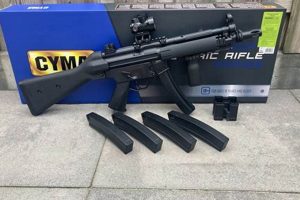
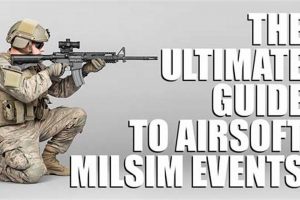
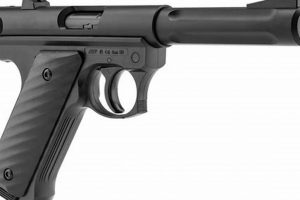
![Dominate Airsoft: Best Uniform Set [Gear Guide] Ultimate Airsoft Guide for Beginners, Tactics & Gear Reviews Dominate Airsoft: Best Uniform Set [Gear Guide] | Ultimate Airsoft Guide for Beginners, Tactics & Gear Reviews](https://airsoftica.com/wp-content/uploads/2025/11/th-818-300x200.jpg)
